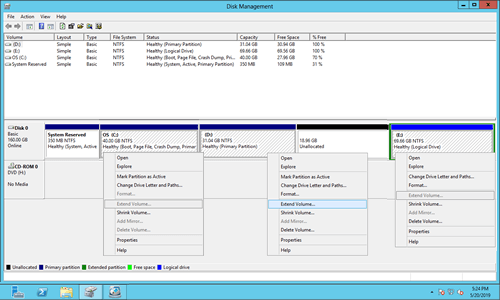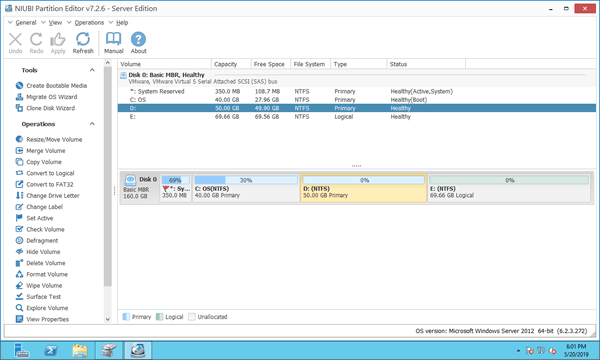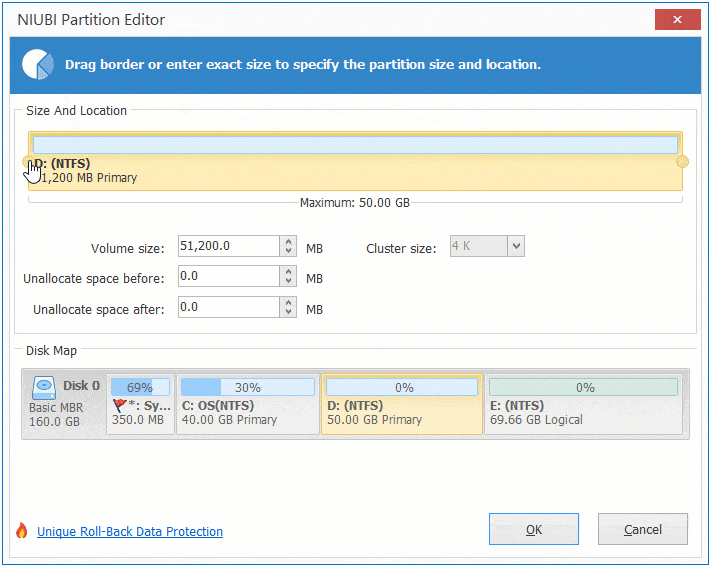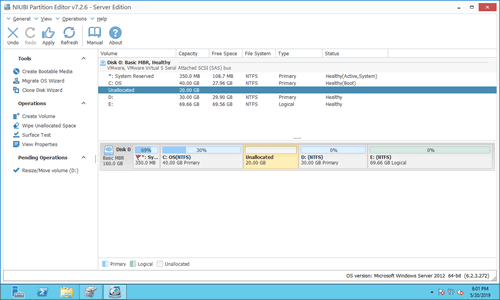It is very common to shrink and extend allocated partition after running the server for a period of time. Some people need to shrink D drive and create more partitions. Some people want to decrease D drive to extend system partition C. Both Windows inbuilt Disk Management and third party tool has the ability to shrink volume in Windows server. This article introduces how to shrink D drive in Windows Server 2012/2016/2019/2022 without losing data.

Shrink D drive with Disk Management
From Windows Server 2008, there's new "Shrink Volume" function in Disk Management console. It is easy to shrink system partition and data volumes without rebooting server. In most cases, it is able to shrink partition without losing data.
How to shrink partition D in Windows Server 2012/2016/2019/2022:
- Press Windows and X on the keyboard, then click "Disk Management" in the list.
- Right click D: drive and select "Shrink Volume".
- Disk Management will calculate and give you all available free space by default value. Enter an amount of space first or click Shrink button directly.
In general, this partition will be shrunk shortly and unlimited space will be made on the right.
Restriction of Disk Management to shrink volume D
Disk Management is easy and works well in most cases, however, you may encounter issue while shrinking partition because of its restrictions.
1. Cannot shrink D beyond limit
There is a tip in the middle of the shrinking window - You cannot shrink a volume beyond the point where any unmovable files are located.
The unmovable files include Paging file, Hibernation and other large files. If any type of unmovable files are located in 3rd block, you cannot shrink this partition to 2nd or 1st block, although there is free space there.

I've encountered such issue while shrinking D drive in my server. It is blank with 50GB free space, but Disk Management gives me only 19417MB (18.96GB) available space to shrink.
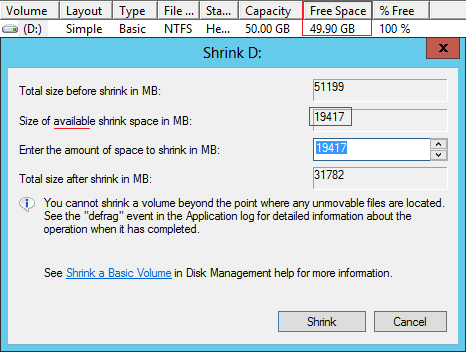
2. Can't shrink FAT32 partition
In Windows PC and Server, both NTFS and FAT32 are common types of partition, but Disk Management only support NTFS partition to shrink or extend. When you right click FAT32 partition, Shrink Volume is disabled.
3. Can't shrink to expand other drive
In many servers, system C drive runs out of space after running for a period of time. It can't be better if you can shrink D to expand C without losing data. Otherwise, it costs a long time to recreate partitions and restore from backup.
There are both Shrink and Extend Volume functions in Disk Management, but it cannot extend C drive and other partitions by shrinking D.
When right click C: and E drive after shrinking D, Extend Volume is grayed out. As I said above, "Shrink Volume" can only decrease a partition towards left and make unallocated space on the right side.
Besides this restriction, "Extend Volume" can only combine unallocated space to the left contiguous partition. C drive is nonadjacent and E is on the right side of the unallocated space, so Extend Volume is disabled.
Shrink D with NIUBI Partition Editor
Comparing with Disk Management, NIUBI Partition Editor is much more powerful:
- Both NTFS and FAT32 partitions are support.
- Unallocated space can be made on either right or left while shrinking partition.
- It can move "unmovable" files and shrink a volume to much smaller.
- Unallocated space can be moved and merged to contiguous and nonadjacent partition on the same disk.
- Besides shrinking and extending volume, it helps merge, convert, clone, defrag, wipe, hide, scan partition, etc.
Download NIUBI Partition Editor and you'll see all disk partitions with structure and other information in the main window.
How to shrink D drive in Server 2012/2016/2019/2022 with NIUBI:
Right click drive D: and select "Resize/Move Volume", you have two options in the pop-up window.
Shrink volume D to expand C and E
To extend other partitions, you just need to drag and drop on the disk map. Watch the video how to shrink D drive to extend C/E in Windows Server 2012 and other versions:
Better than other tools, NIUBI Partition Editor has Virtual Mode, Cancel-at-will, 1-Second Rollback and Hot Clone technology to protect system and data. Besides shrinking and extending partitions, it helps you do many other disk/partition management operations.

